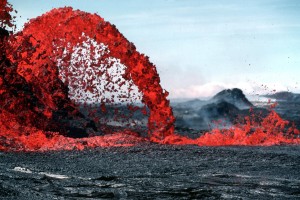TUESDAY, 4 SEPTEMBER 2012
Hotspots are areas where the mantle under the Earth’s crust is at a particularly high temperature with a large proportion of melt and which fuel volcanism on the surface. Archipelagos such as Hawaii and the Azores are formed in this way, with the gradual movement of the plates across stationary hotspots producing lines of oceanic volcanoes.Many scientists explain the existence of hot spots with reference to mantle plumes – narrow channels of hot rock rising from the boundary between Earth’s core and its mantle, 2900km below the surface. These hot plumes cause the mantle at shallower depths to melt, though their origin is controversial and their very existence sometimes challenged.
Scientists from the Centre National de la Recherche Scientifique in Clermont, France, and the European Synchrotron Radiation Facility in Grenoble, aimed to replicate the conditions at the core-mantle boundary using minute samples of rock. They heated the samples to 3-4000oC using a laser beam and replicated the enormous pressures within the Earth by compressing the sample in a diamond anvil.
Using the world’s most powerful X-ray beam just one thousandth of a millimetre wide, the team could see where the samples were melting. By analysing the iron composition of the rock, the density of the melt and its propensity to rise to form a plume could be determined.
The team, led by Denis Andrault of the Laboratoire Magmas et Volcans of University Blaise Pascal in Clermont, found that under the extreme conditions at the core-mantle boundary, low-density molten rock forms which could rise to form a mantle plume. This study provides another clue as to how these huge features might arise.
DOI: 10.1038/nature11294
Written by Amelia Penny

